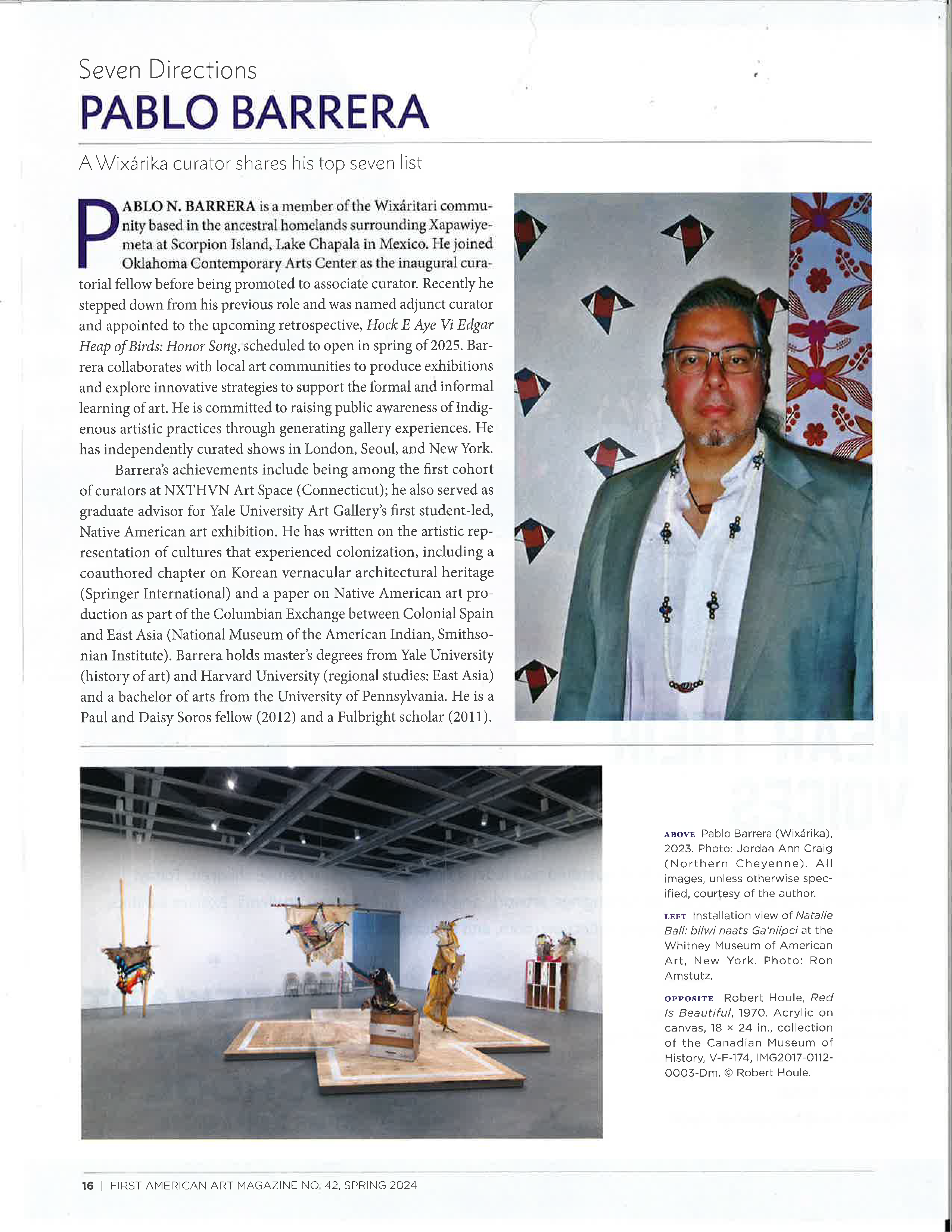
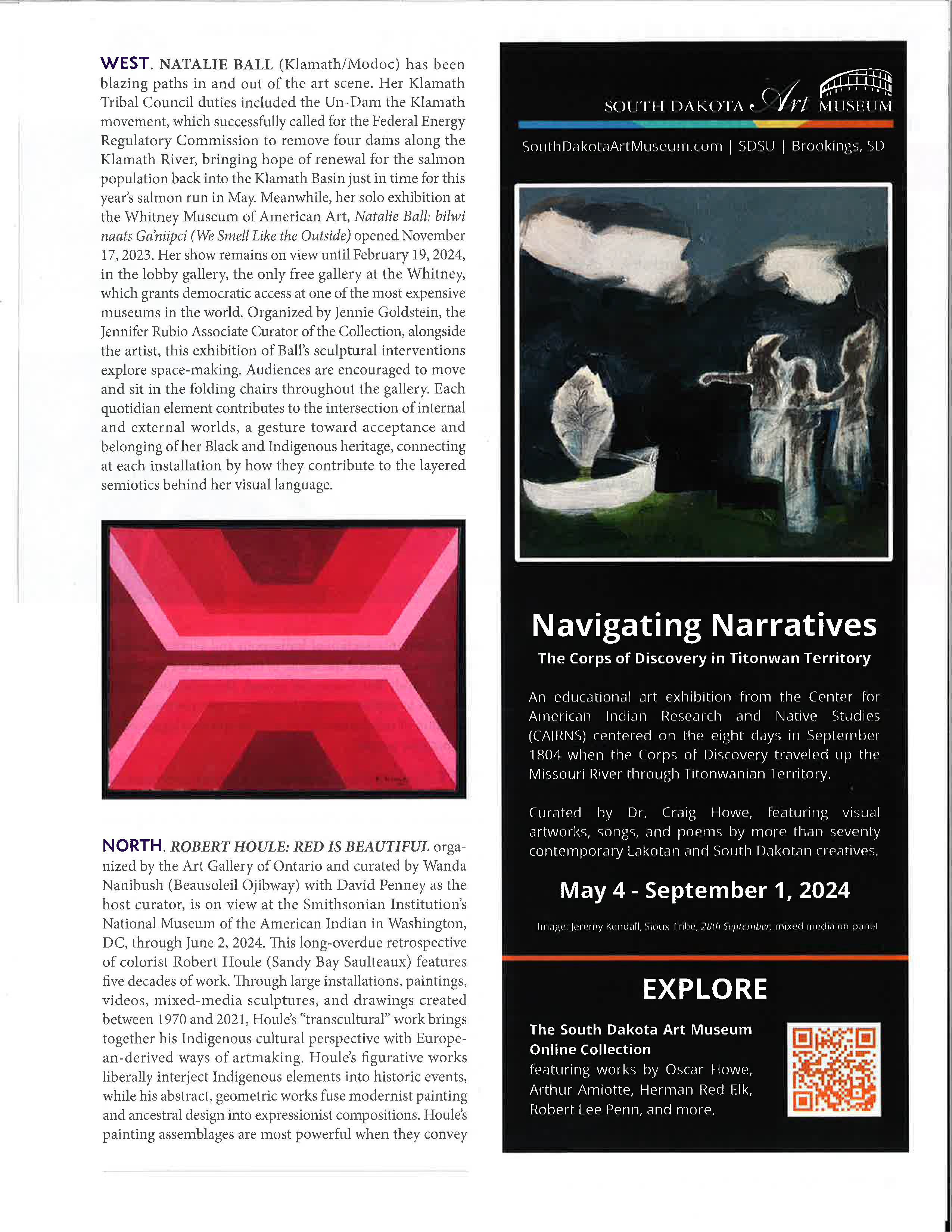
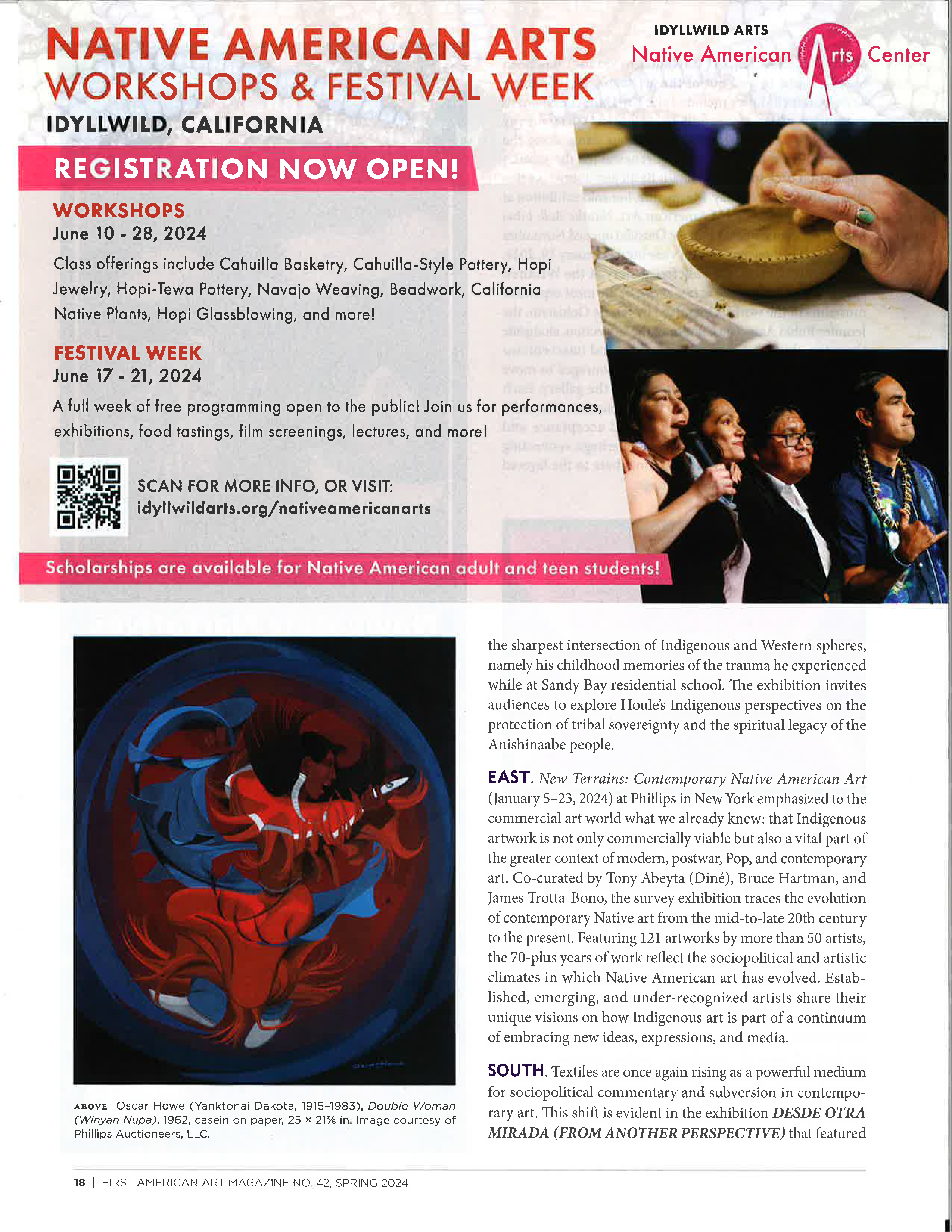
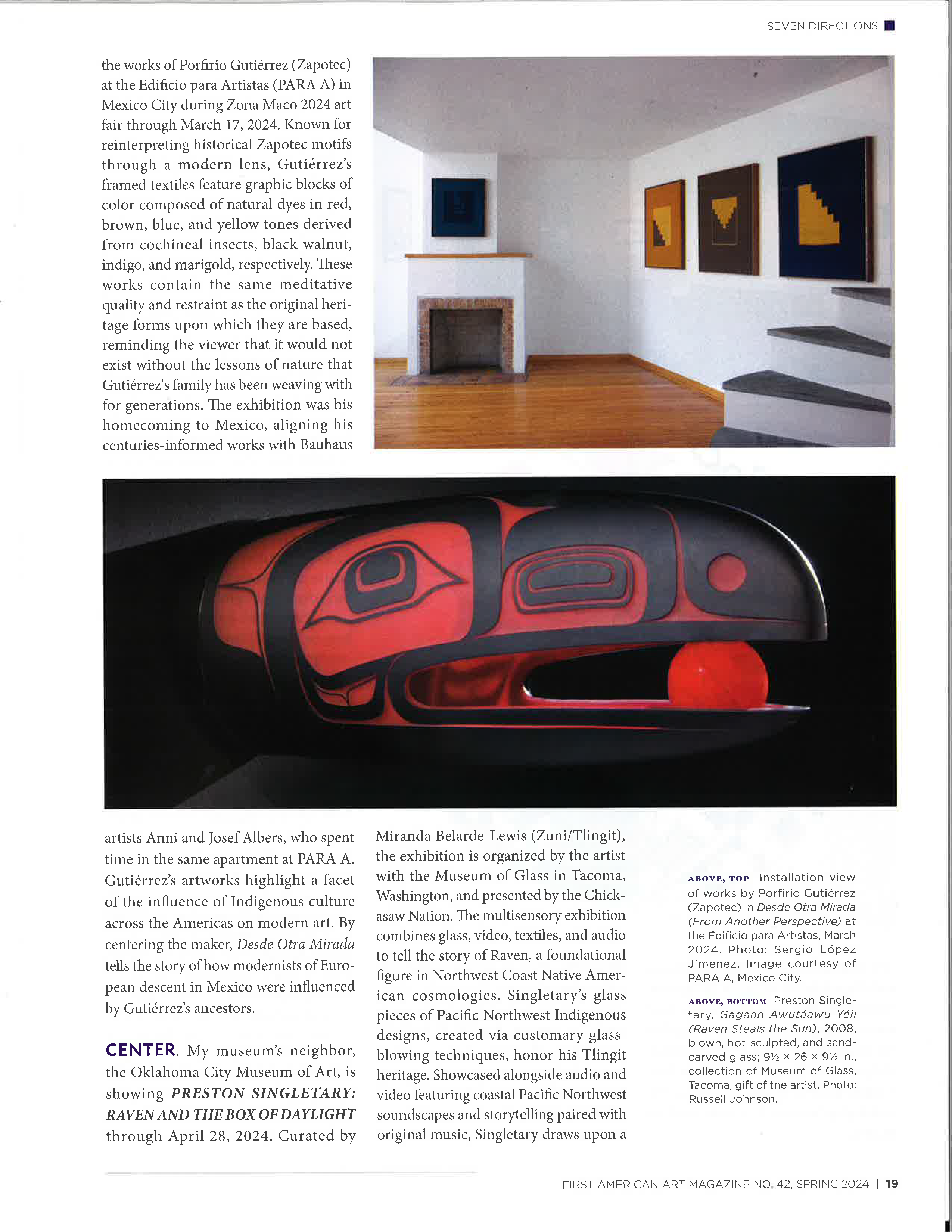
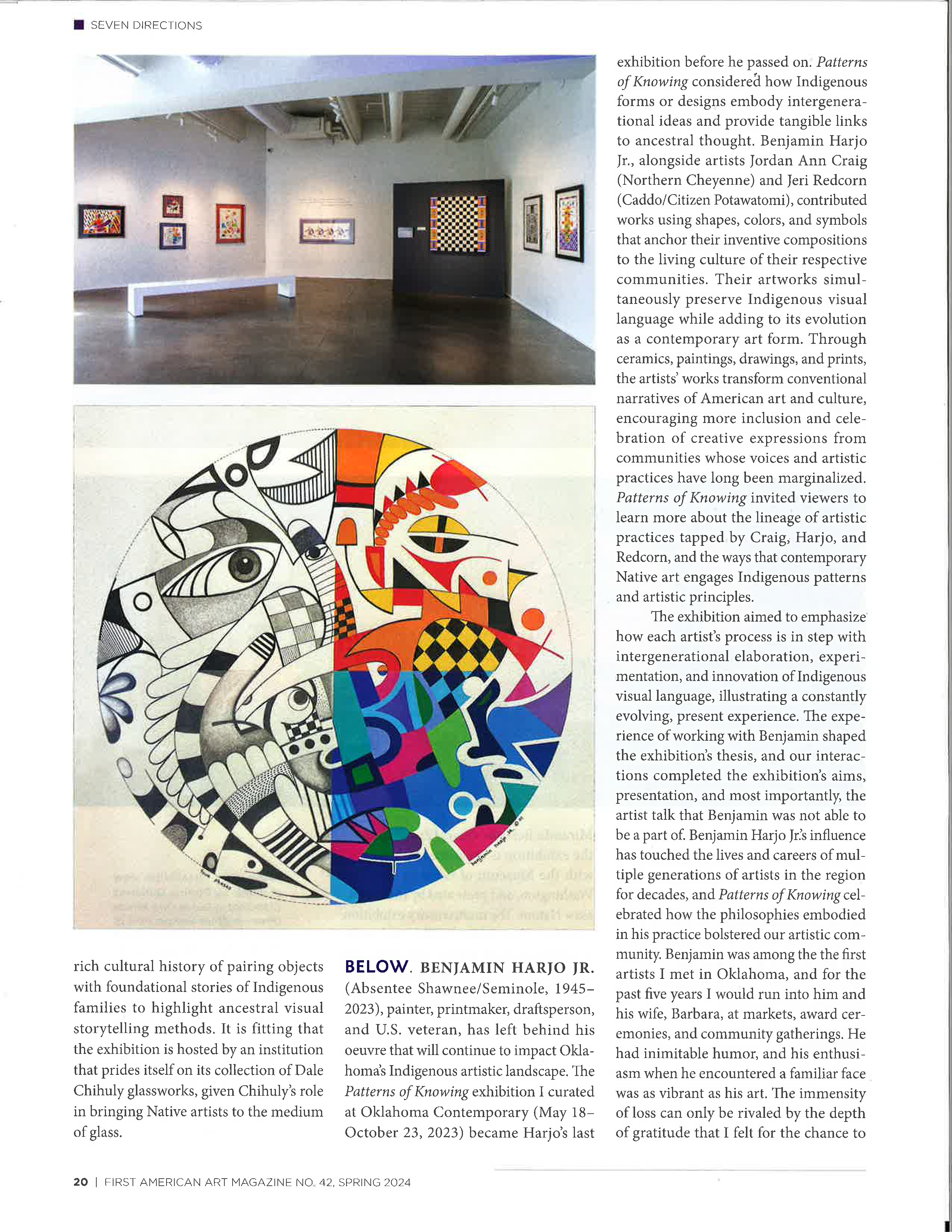
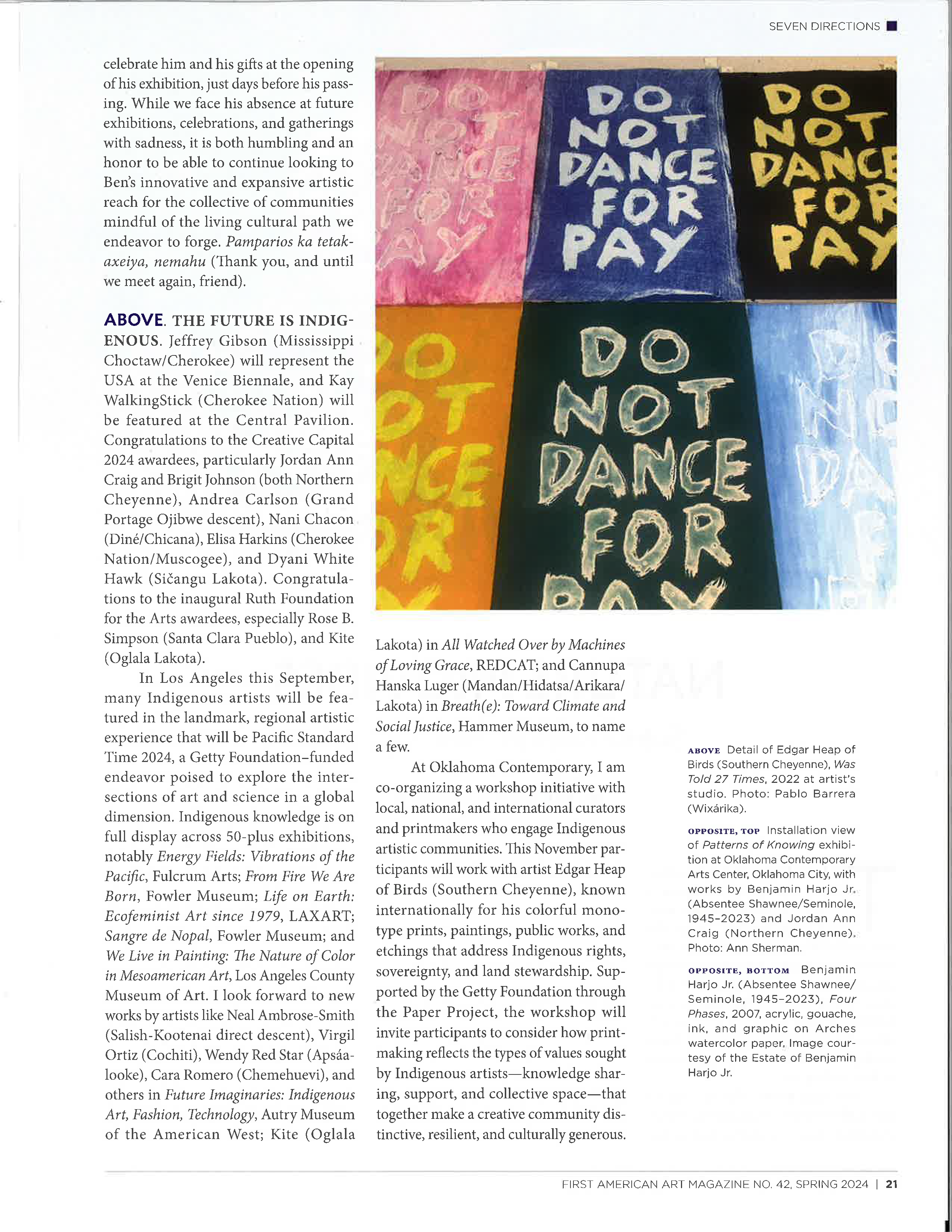
A Wixárika curator shares his top seven list
PABLO N. BARRERA is a member of the Wixáritari community based in the ancestral homeland surrounding Xapawiyemeta at Scorpion Island, Lake Chapa]a in Mexico. He joined Oklahoma Contemporary Arts Center as the inaugural curatorial fellow before being promoted to associate curator. Recently he stepped down from his previous role and was named adjunct curator and appointed to the upcoming retrospective, Hock E Aye Vi Edgar Heap of Birds: Honor Song, scheduled to open in spring of 2025. Barrera collaborates with local art communities to produce exhibitions and explore innovative strategies to support the formal and informal learning of art. He is committed to raising public awareness of lndigenous artistic practices through generating gallery experiences. He has independently curated shows in London, Seoul, and New York.
Barrera's achievements include being among the first cohort of curators at NXTHVN Art Space (Connecticut); he also served as graduate advisor for Yale University Art Gallery's first student-led, Native American art exhibition. He has written on the artistic representation of cultures that experienced colonization, including a coauthored chapter on Korean vernacular architectural heritage (Springer International) and a paper on Native American art production as part of the Columbian Exchange between Colonial Spain and East Asia (National Museum of the American Indian, Smithsonian Institute). Barrera holds master's degrees from Yale University (history of art) and Harvard University (regional studies: East Asia) and a bachelor of arts from the University of Pennsylvania. He is a Paul and Daisy Soros fellow (2012) and a Fulbright scholar (2011).
WEST. NATALIE BALL (Klamath/Modoc) has been blazing paths in and out of the art scene. Her Klamath Tribal Council duties included the Un-Dam the Klamath
movement, which successfully called for the Federal Energy Regulatory Commission to remove four dams along the Klamath River, bringing hope of renewal for the salmon population back into the Klamath Basin just in time for this year's salmon run in May. Meanwhile, her solo exhibition at the Whitney Museum of American Art, Natalie Ball: bilwi naats Ga'niipci (We Smell Like the Outside) opened November 17, 2023. Her show remains on view until February 19, 2024, in the lobby gallery, the only free gallery at the Whitney, which grants democratic access at one of the most expensive museums in the world. Organized by Jennie Goldstein, the
Jennifer Rubio Associate Curator of the Collection, alongside the artist, this exhibition of Ball's sculptural interventions explore space-making. Audiences are encouraged to move and sit in the folding chairs throughout the gallery. Each quotidian element contributes to the intersection of internal and external worlds, a gesture toward acceptance and belonging of her Black and Indigenous heritage, connecting at each installation by how they contribute to the layered semiotics behind her visual language.
NORTH. ROBERT HOULE: RED IS BEAUTIFUL organized by the Art Gallery of Ontario and curated by Wanda Nanibush (Beausoleil Ojibway) with David Penney as the host curator, is on view at the Smithsonian Institution's National Museum of the American Indian in Washington, DC, through June 2, 2024. This long-overdue retrospective of colorist Robert Houle (Sandy Bay Saulteaux) features five decades of work. Through large installations, paintings, videos, mixed-media sculptures, and drawings created between 1970 and 2021, Houle's "transcultural" work brings together his Indigenous cultural perspective with European-derived ways of artmaking. Houle's figurative works liberally interject Indigenous elements into historic events, while his abstract, geometric works fuse modernist painting and ancestral design into expressionist compositions. Houle's painting assemblages are most powerful when they convey the sharpest intersection of lndigenous and Western spheres, namely his childhood memories of the trauma he experienced while at Sandy Bay residential school. The exhibition invites audiences to explore Houle's Indigenous perspectives on the protection of tribal sovereignty and the spiritual legacy of the Anishinaabe people.
EAST. New Terrains: Contemporary Native American Art (January 5-23, 2024) at Phillips in New York emphasized to the commercial art world what we already knew: that Indigenous artwork is not only commercially viable but also a vital part of the greater context of modern, postwar, Pop, and contemporary art. Co-curated by Tony Abeyta (Dine), Bruce Hartman, and James Trotta-Bono, the survey exhibition traces the evolution of contemporary Native art from the mid-to-late 20th century to the present. Featuring 121 artworks by more than 50 artists, the 70-plus years of work reflect the sociopolitical and artistic climates in which Native American art has evolved. Established, emerging, and under-recognized artists share their unique visions on how Indigenous art is part of a continuum of embracing new ideas, expressions, and media.
SOUTH. Textiles are once again rising as a powerful medium for sociopolitical commentary and subversion in contemporary art. This shift is evident in the exhibition DESDE OTRA MIRADA (FROM ANOTHER PERSPECTIVE) that featured the works of Porfirio Gutiérrez (Zapotec) at the Edificio para Artistas (PARA A) in Mexico City during Zona Maco 2024 art fair through March 17, 2024. Known for reinterpreting historical Zapotec motifs through a modern lens, Gutiérrez's framed textiles feature graphic blocks of color composed of natural dyes in red, brown, blue, and yellow tones derived from cochineal insects, black walnut, indigo, and marigold, respectively. These works contain the same meditative quality and restraint as the original heritage forms upon which they are based, reminding the viewer that it would not exist without the lessons of nature that Gutiérrez's family has been weaving with for generations. The exhibition was his homecoming to Mexico, aligning his centuries-informed works with Bauhaus artists Anni and Josef Albers, who spent time in the same apartment at PARA A. Gutiérrez's artworks highlight a facet of the influence of Indigenous culture across the Americas on modern art. By centering the maker, Desde Otra Mirada tells the story of how modernists of European descent in Mexico were influenced by Gutiérrez's ancestors.
CENTER. My museum's neighbor, the Oklahoma City Museum of Art, is showing PRESTON SINGLETARY: RAVEN AND THE BOX OF DAYLIGHT through April 28, 2024. Curated by Miranda Belarde-Lewis (Zuni/Tlingit), the exhibition is organized by the artist with the Museum of Glass in Tacoma, Washington, and presented by the Chickasaw Nation. The multisensory exhibition combines glass, video, textiles, and audio to tell the story of Raven, a foundational figure in Northwest Coast Native American cosmologies. Singletary's glass pieces of Pacific Northwest Indigenous designs, created via customary glassblowing techniques, honor his Tlingit heritage. Showcased alongside audio and video featuring coastal Pacific Northwest soundscapes and storytelling paired with original music, Singletary draws upon a rich cultural history of pairing objects with foundational stories of Indigenous families to highlight ancestral visual storytelling methods. It is fitting that the exhibition is hosted by an institution that prides itself on its collection of Dale Chihuly glassworks, given Chihuly's role in bringing Native artists to the medium of glass.
BELOW. BENJAMIN HARJO JR. (Absentee Shawnee/Seminole, 1945-2023), painter, printmaker, draftsperson, and U.S. veteran, has left behind his oeuvre that will continue to impact Oklahoma's Indigenous artistic landscape. The Patterns of Knowing exhibition I curated at Oklahoma Contemporary (May 18-October 23, 2023) became Harjo's last exhibition before he passed on. Patterns of Knowing considered how Indigenous forms or designs embody intergenerational ideas and provide tangible links to ancestral thought. Benjamin Harjo Jr., alongside artists Jordan Ann Craig (Northern Cheyenne) and Jeri Redcorn (Caddo/Citizen Potawatomi), contributed works using shapes, colors, and symbols that anchor their inventive compositions to the living culture of their respective communities. Their artworks simultaneously preserve Indigenous visual language while adding to its evolution as a contemporary art form. Through ceramics, paintings, drawings, and prints, the artists' works transform conventional narratives of American art and culture, encouraging more inclusion and celebration of creative expressions from communities whose voices and artistic practices have long been marginalized. Patterns of Knowing invited viewers to learn more about the lineage of artistic practices tapped by Craig, Harjo, and Redcorn, and the ways that contemporary Native art engages Indigenous patterns and artistic principles.
The exhibition aimed to emphasize how each artist's process is in step with intergenerational elaboration, experimentation, and innovation of lndigenous visual language, illustrating a constantly evolving, present experience. The experience of working with Benjamin shaped the exhibition's thesis, and our interactions completed the exhibition's aims, presentation, and most importantly, the artist talk that Benjamin was not able to be a part of. Benjamin Harjo Jr.'s influence has touched the lives and careers of multiple generations of artists in the region for decades, and Patterns of Knowing celebrated how the philosophies embodied in his practice bolstered our artistic community. Benjamin was among the the first artists I met in Oklahoma, and for the past five years I would run into him and his wife, Barbara, at markets, award ceremonies, and community gatherings. He had inimitable humor, and his enthusiasm when he encountered a familiar face was as vibrant as his art. The immensity of loss can only be rivaled by the depth of gratitude that I felt for the chance to celebrate him and his gifts at the opening of his exhibition, just days before his passing. While we face his absence at future exhibitions, celebrations, and gatherings with sadness, it is both humbling and an honor to be able to continue looking to Ben's innovative and expansive artistic reach for the collective of communities mindful of the living cultural path we endeavor to forge. Pamparios ka tetakaxeiya, nemahu (Thank you, and until we meet again, friend).
ABOVE. THE FUTURE IS INDIGENOUS. Jeffrey Gibson (Mississippi Choctaw/Cherokee) will represent the USA at the Venice Biennale, and Kay WalkingStick (Cherokee Nation) will be featured at the Central Pavilion. Congratulations to the Creative Capital 2024 awardees, particularly Jordan Ann Craig and Brigit Johnson (both Northern Cheyenne), Andrea Carlson (Grand Portage Ojibwe descent), Nani Chacon (Dine/Chicana), Elisa Harkins (Cherokee Nation/Muscogee), and Dyani White Hawk (Sicangu Lakota). Congratulations to the inaugural Ruth Foundation for the Arts awardees, especially Rose B. Simpson (Santa Clara Pueblo), and Kite (Oglala Lakota).
In Los Angeles this September, many Indigenous artists will be featured in the landmark, regional artistic experience that will be Pacific Standard Time 2024, a Getty Foundation-funded endeavor poised to explore the intersections of art and science in a global dimension. Indigenous knowledge is on full display across 50-plus exhibitions, notably Energy Fields: Vibrations of the Pacific, Fulcrum Arts; From Fire We Are Born, Fowler Museum; Life on Earth: Ecofeminist Art since 1979, LAXART; Sangre de Nopal, Fowler Museum; and We Live in Painting: The Nature of Color in Mesoamerican Art, Los Angeles County Museum of Art. I look forward to new works by artists like Neal Ambrose-Smith (Salish-Kootenai direct descent), Virgil Ortiz (Cochiti), Wendy Red Star (Apsáalooke), Cara Romero (Chemehuevi), and others in Future Imaginaries: Indigenous Art, Fashion, Technology, Autry Museum of the American West; Kite (Oglala Lakota) in All Watched Over by Machines of Loving Grace, REDCAT; and Cannupa Hanska Luger (Mandan/Hidatsa/ Arikara/Lakota) in Breath(e): Toward Climate and Social Justice, Hammer Museum, to name
a few.
At Oklahoma Contemporary, I am co-organizing a workshop initiative with local, national, and international curators and printmakers who engage Indigenous artistic communities. This November participants will work with artist Edgar Heap of Birds (Southern Cheyenne), known internationally for his colorful monotype prints, paintings, public works, and etchings that address Indigenous rights, sovereignty, and land stewardship. Supported by the Getty Foundation through the Paper Project, the workshop will invite participants to consider how printmaking reflects the types of values sought by Indigenous artists-knowledge sharing, support, and collective space-that together make a creative community distinctive, resilient, and culturally generous.









